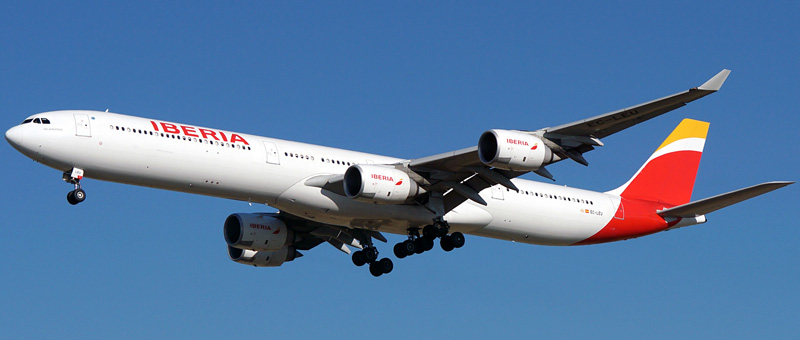
Seat map Airbus A340-600 Iberia. Best seats in the plane
Iberia operates 2 versions of Airbus A340-600.
First cabin version of the Airbus A340-600 (346) V1
First version of Airbus A340-600 is the most common in Iberia fleet among two versions.
This airplane is used during long-haul flights.
This version offers 46 flat bed seats of business class and 300 seats of economy class.
Business Plus class consists of 12 rows of seats. These seats have 180 degrees recline. The noise from the galleys and lavatory may represent a problem for passengers of the seats 1A and 1L and for passengers of the last 12th row.
Passengers traveling with babies are often seated on the seats 2E and 2G as these seats offer bassinet locations.
Economy class seats are located in three sections separated from each other with exit rows. Most of the economy class seats have 2-4-2 configuration.
First section consists of 11 rows of seats. Due to the exit row in front the seats 14AC and 14JL have extra legroom. Among disadvantages: close location of the galleys and lavatories, reduced width and lack of floor storage during take-off and landing.
Because of the position of the bulkhead the seats 15DEGH have limited legroom. These seats may have no floor storage during take-off and landing. For passengers with babies these seats offer bassinet locations.
The second section of economy class seats include 15 rows. Passengers of the seats 25AC and 25JL will take advantage of extra space for their legs. Missing windows , lack of floor storage during take-off and landing make the seats 25A and 25L bad seats.
Congregation of passengers near lavatories and limited recline are the main disadvantages of the seats 38AC, 38 JL and 39DEGH.
The third section of economy class seats has 14 rows. Passengers of the seats 40AC and 40JL will feel comfortable thanks to extra legroom. As the tray tables are in the armrests the width of these seats is slightly reduced. Other passengers tend to gather in the area of these seats while waiting to use lavatories thus causing discomfort to passengers of these seats. Also these seats may have no floor storage during take-off and landing.
The seats 41DEGH have the following disadvantages: limited legroom, location of the galley in front and lack of floor storage during take-off and landing.
Due to missing seats behind the seats 50D and 50H are often bumped by other passengers and service carts passing by.
As there is no seat in front the seat 52D offers extra legroom. But proximity of the galleys and lavatories will cause discomfort for passengers of this seat and of the seat 52H.
The seats 52AC, 52JL and 53DEH are considered bad seats due to limited recline and close location of the lavatories and galleys.
Second cabin version of the Airbus A340-600 (346) V2
Second version of Airbus A340-600 operated by Iberia may transport 342 passengers in tow classes: business and economy.
Business class consists of 42 angle-flat seats that have 170 degrees recline. These seats are located in 7 rows per 6 in each. Each row has 2-2-2 configuration of seats.
Location of the galleys and lavatory in front will cause discomfort to passengers’ of the seats 1C, 1DH and 1J.
The only disadvantage of the seats 6A and 6L are misaligned windows.
The noise from the galleys and lavatories located behind the seats 7C, 7DH and 7J will cause inconvenience to passengers’ of these seats.
Behind business class seats 300 standard seats of economy class are located. The seats of the economy class have 2-4-2 configuration.
Economy class is divided into three sections.
First section consists of 11 rows. Passengers of the seats 10AC, 10JL and 11DEGH will take advantage of extra legroom. However, these seats have also some disadvantages: the tray tables are built-in the armrests making them immovable and thus reducing the width of these seats a little. Also these seats have no floor storage during take-off and landing. Close location of the galleys may cause discomfort as well.
Due to the exit row located behind the seats of the 21st row are less reclining than standard.
Second section of economy class seats includes 15 rows. The seats of the 22nd row are a little narrower than standard and have no floor storage during take-off and landing. Also, the seat 22A and 22L have limited space for passengers’ legs due to protrusion of the exit doors inside. The best seats of the economy class are the seats 22C, 22DEGH and 22J. Passengers of these seats will feel comfortable thanks to extra legroom.
The seats 23A and 23 L are considered bad seats because of missing windows.
Proximity of the lavatories and limited recline are the main disadvantages of the seats 35AC, 35JK and 36DEGH.
The third section has 14 rows of seats. The main disadvantages of the seats 37AC, 37JL and 38DEGH are: congregation of passengers in the area of these seats in order to visit lavatories, reduced width as the tray tables are in the armrests making them immovable and lack of floor storage during take-off and landing. Also, the seats 37A and 37L have reduced legroom because the exit doors protrude inside. Passengers of the seats 37C, 37J and 38DEGH on the contrary will take advantage of additional space for their legs.
Because of configuration change of the seats from 4 to 3, the seats 47D and 47H are often bumped by service carts but the seats 48D and 48H have limited legroom. Also the seats 48D and 48H are a little narrower than standard.
The noise from the galleys and lavatories located behind and limited recline make the seats 49AC, 49JL and 50DEH bad seats.
Useful information about “Iberia”
- Rating and reviews about “Iberia”
- Airbus A340-600 Iberia. Photos and description of the plane
- Iberia – company description and aircrafts fleet


